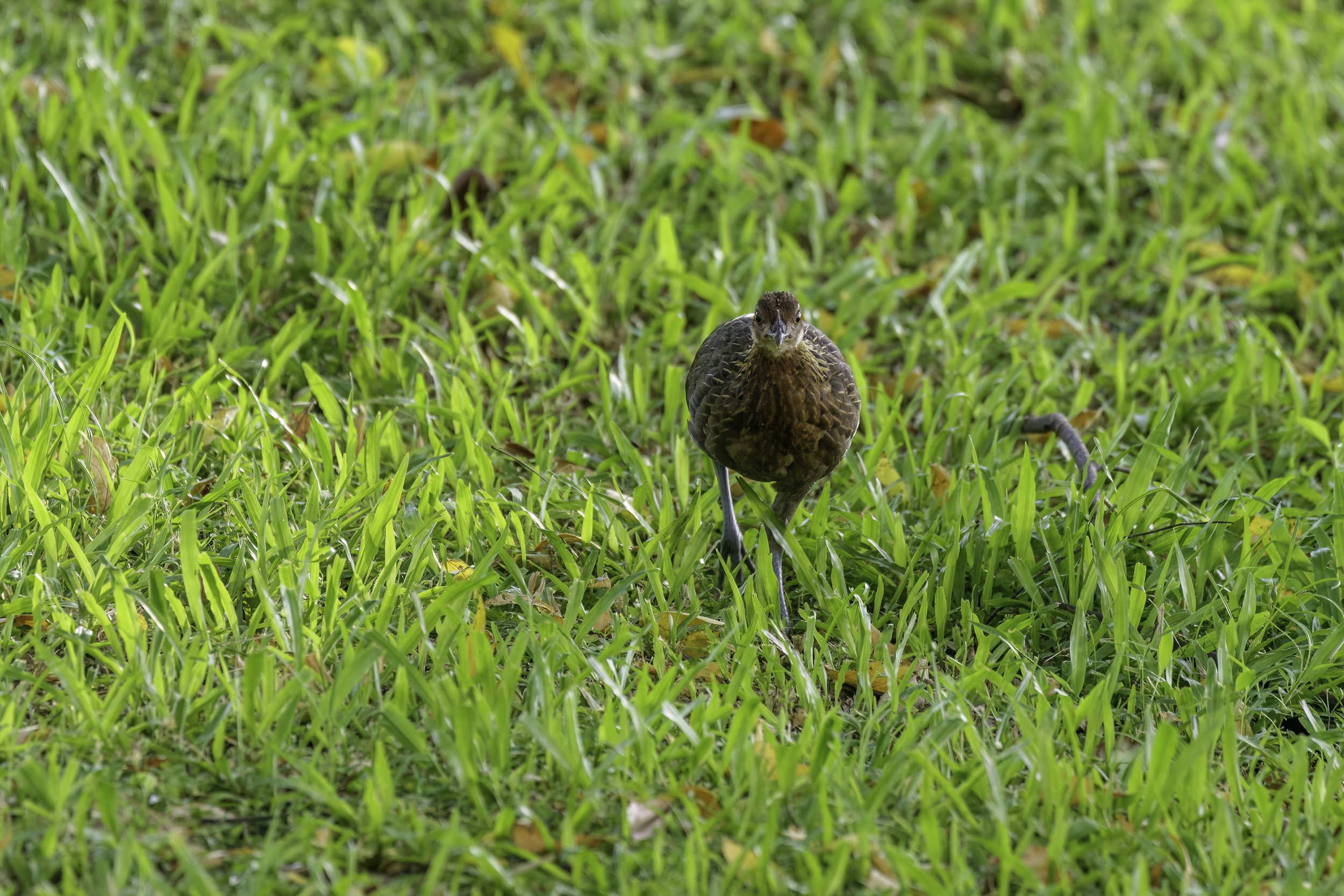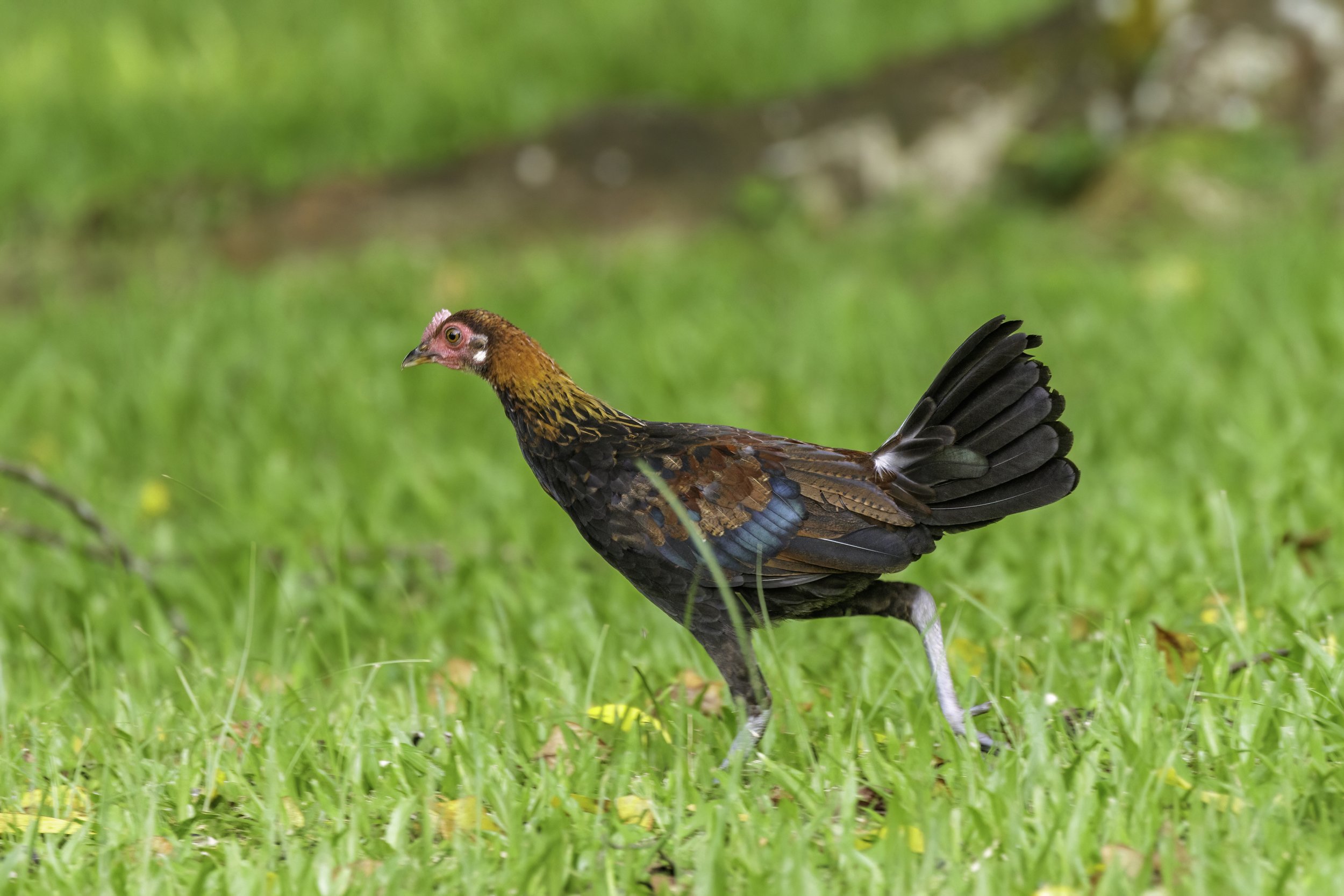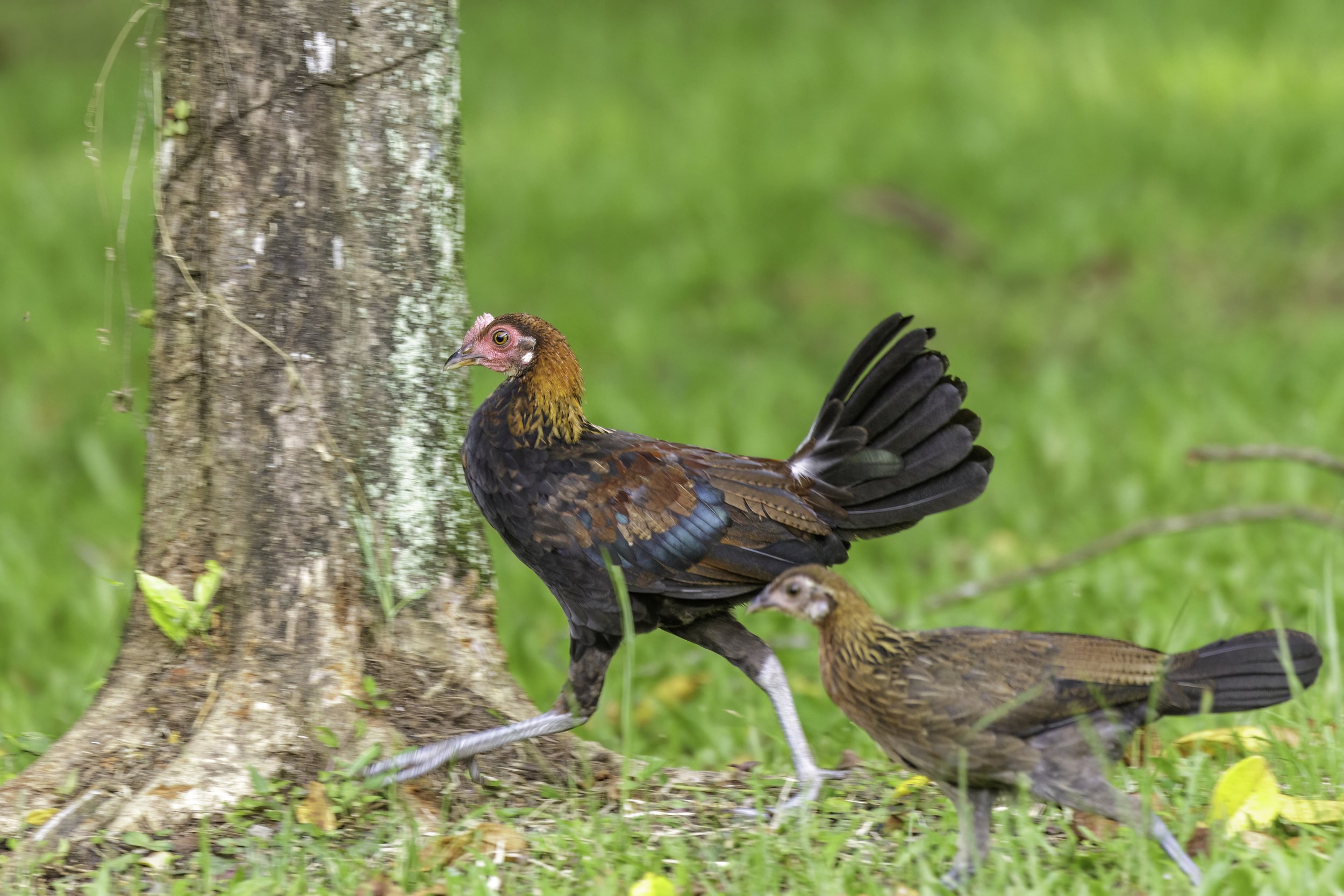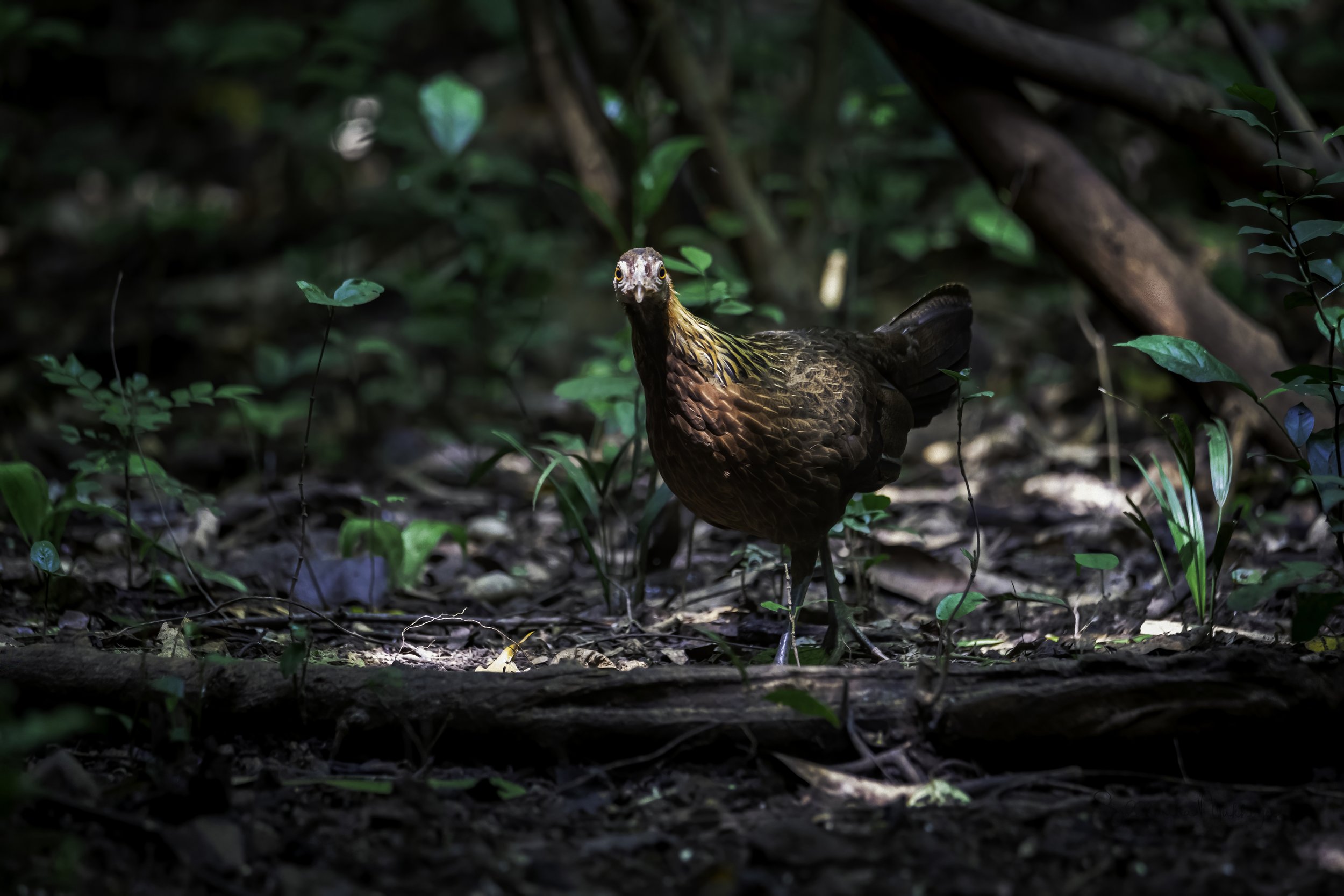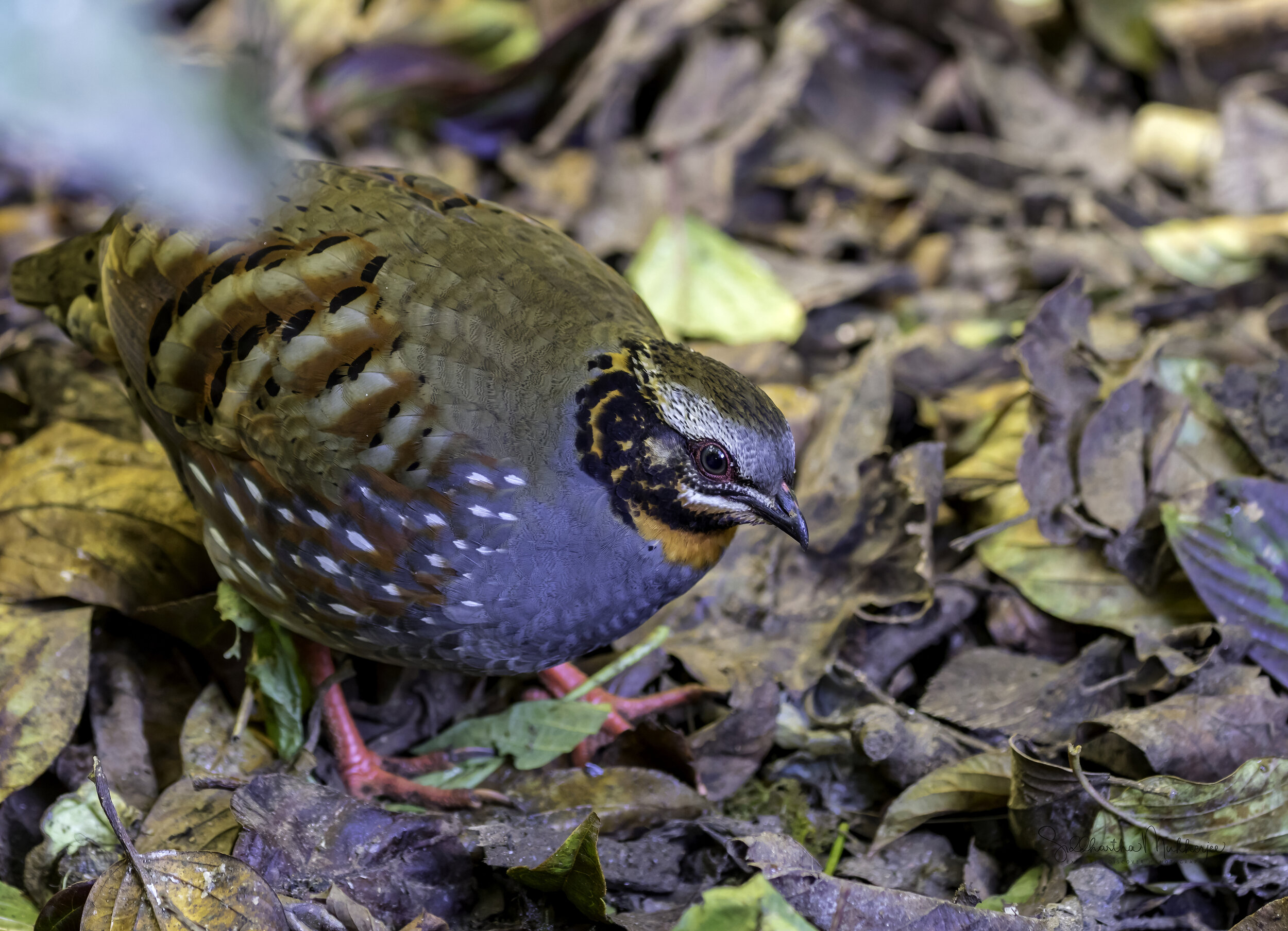Red Junglefowl
Gallus gallus
Jungles all over India, Malaysia, Thailand, Indonesia & Singapore
I am sure those who have read stories of shikar, especially Jim Corbett or Kenneth Anderson, will wholeheartedly agree that this is a bird they have often come across as both shikaris sat down for their meals. Junglefowl are the only four living species of bird from the genus Gallus in the bird order Galliformes, and occur in parts of South and Southeast Asia. One of the species in this genus, the Red Junglefowl, is of historical importance as the direct ancestor of the domestic chicken (Gallus gallus domesticus), although the Gray Junglefowl, Sri Lankan Junglefowl and Green Junglefowl are likely to have also been involved.
There are times, I remember from my childhood at my grandparents, when door to door vendors would sometimes arrive at our home with junglefowl in large cane baskets. This used to be a very special treat, like quail. For a brief period in time, during the 80s, these game birds were farmed & were available at speciality shops which stocked game birds. Fortunately or unfortunately with the increasing industrialisation of food, and the homogenisation of tastes that followed, these farms either shut down or turned to battery farming of chicken. As a result my memories of game birds has faded over the years.
But those times spent at my grandparents was a learning in shikar, tracking and behaviours of the multitude of birds and animals that inhabit our jungles. And when I started photography I fell right back into those stories of the jungles and finding and documenting the birds and animals I had heard and dreamt of.
Red Junglefowl - Male
Red Junglefowl - Female
I have encountered the Red Junglefowl at a number of different locations - from the dense rainforests of the Kaeng Krachan National Park to the urban wilds of the Windsor Nature Trail in Singapore and the emerald forests of India.
Kaeng Krachan National Park is the largest national park of Thailand on the border with Burma, contiguous with the Tanintharyi Nature Reserve. It is located in Phetchaburi and Prachuap Khiri Khan Provinces, about 60 km from Phetchaburi and 75 km from Hua Hin. Covering an area of 2,914 km² it is the largest national park in Thailand. The park is part of the Western Forex Complex that covers 18,730 km² across 19 protected sites between Myanmar and Thailand, bounded by the Tanintharyi Nature Reserve along Myanmar's border to the west. A dense rain forest on the eastern slope of the Tenasserim Mountain Range where the Pranburi & Phetchaburi Rivers originate. Both rivers originate from the Tanaosri Mountain Range. In the north, Phetchaburi River flows into Kaeng Krachan Dam and flows further east all the way out to the Gulf of Thailand. Pran Buri River flows south to Prachuap Khiri Khan Province, into Pran Buri Reservoir and out to the Gulf of Thailand.
The park was declared a reserve in 1964 and on 12 June 1981 it became the 28th national park of Thailand. Originally covering an area of 2,478 km², it was enlarged in December 1984 to include the boundary area between Phetchaburi and Prachuap Khiri Khan Provinces, an additional 300,000 rai. The park has been included in the list of ASEAN Heritage Parks. Since 2011, Thailand has proposed that Unesco designate Kaeng Krachan National Park a world heritage site.
Mammal species such as leopards, clouded leopards, bears, stump-tailed macaques, sambar deer, barking deer, elephants, dholes, golden jackals, gaurs, serows, yellow-throated martens, various civet species, crab-eating mongooses and many others can be found in the park.
Windsor Nature Park
Ask any local “where to hike in Singapore”, and chances are the MacRitchie Treetop Walk will come up. With scenic views of the MacRitchie Reservoir plus an Instagram-worthy 250m-long suspension bridge, its popularity comes as no surprise. But this isn’t where we are at today. We are at the Windsor Nature Park located adjacent to MacRitchie and which also has a 150m elevated walkway. Opened in 2017, Windsor Nature Park is one of Singapore’s newer parks. It has approximately 4km of trails spread over 75 hectares — it might not be the largest park, but the many freshwater streams running through the park make it unique. Some of the trails within the park include the wheelchair-friendly Hanguana Trail, the scenic Squirrel and Drongo Trail and the more rugged Venus Loop. Windsor Nature Park is protected as part of the Central Nature Park Network.
Windsor Nature Park is located on the eastern side of Singapore’s Central Catchment Nature Reserve (CCNR). While it is currently predominantly a regenerating secondary forest, much of the land once served as a rubber plantation. Up until the 1950s, kampong villages and remnants of an aquatic plant farm existed on site. Visitors familiar with the area would take a natural trail leading to the TreeTop Walk, a key attraction in MacRitchie. The planning of the nature park is based on three objectives put forth at its inception:
strengthening the integrity of the CCNR through preservation of a green buffer that protects the nature reserve core from surrounding urban impacts;
providing enhanced recreational possibilities in a natural environment; and
promoting appreciation of Singapore’s natural and cultural heritage through education and community involvement.
Set amidst a backdrop of green oasis & a marsh habitat teeming with biodiversity, the amenities at Windsor Nature Park are thoughtfully integrated with the lush greenery. At the entrance node, the back of the visitor pavilion was designed to face northeast with the intention to screen off the glaring heat of the morning sun. The green roof of the visitor pavilion is planted with Seashore Centipede Grass (Ischaemum muticum), Moss-rose purslane (Portulaca grandiflora), Bamboo Orchid (Arundina graminifolia) & Tropical Carpet Grass (Axonopus compressus var. dwarf) helping not only to maintain a cool temperature under the pavilion, but also providing respite from the sun and rain.
Sensitive enhancement of the nature park began in early 2014. Within the entrance node a newly-created wetland, which includes an area broadened out to form a marsh habitat, is planted with native plant species such as the Spiny Lasia (Lasia spinosa) and the Aquatic Ginger (Alpinia aquatica). Due to the topography of the area and a high water table, much of the terrain at the entrance node was initially flooded during heavy rain. The wetland was created to divert away excess storm water runoff, to transform the area into an additional wetland habitat for the biodiversity associated with the existing stream network. The stream is a habitat for a number of rare species, so the protection of the banks and adjacent land was of outmost importance during the enhancement of the park. Water monitoring and biodiversity assessments were carried out during the planning and construction phases to ensure that the health of the stream systems were being maintained.
As part of the enhancements, existing trails were repaired. New trails and raised boardwalks were added to the trail network to minimise compaction on tree roots, and to enhance the experience of nature lovers by bringing them through a dynamic spatial journey. From the entrance node, a section of Venus Loop which runs along the newly created wetland leads to the Hanguana Trail, an educational trail planted with native plants, and upward into the swampy habitat of the Squirrel Trail then continuing further to the elevated boardwalk (Drongo Trail). The Drongo Trail loops back to the Venus Link, where remnants of the kampong house foundation and former aquatic farm can be seen along the streamside trail. Here, a rich biodiversity of dragonflies can be seen. Since 2008, NParks and researchers have recorded 56 dragonfly species in Windsor Nature Park, which is nearly half of the 122 dragonfly species found in Singapore.
Red Junglefowl
Junglefowl are the only four living species of bird from the genus Gallus in the bird order Galliformes, and occur in parts of South and Southeast Asia. One of the species in this genus, the Red Junglefowl, is of historical importance as the direct ancestor of the domestic chicken, although the Gray Junglefowl, Sri Lankan Junglefowl and Green Junglefowl are likely to have also been involved. The Sri Lankan Junglefowl is the national bird of Sri Lanka. They diverged from their common ancestor about 4–6 million years ago. Although originating in Asia, remains of junglefowl bones have also been found in regions of Chile, which date back to 1321–1407 CE, providing evidence of possible Polynesian migration through the Pacific Ocean.
The junglefowl are omnivorous, eating a variety of leaves, plant matter, invertebrates such as slugs and insects, and occasionally small mice and frogs. These are large birds, with colourful plumage in males, but are nevertheless difficult to see in the dense vegetation they inhabit.
As with many birds in the pheasant family, the male takes no part in the incubation of the egg or rearing of the precocial young. These duties are performed by the drab and well-camouflaged female. Females and males do not form pair bonds; instead, the species has a polygynandrous mating system in which each female will usually mate with several males. Aggressive social hierarchies exist among both females and males, from which the term "pecking order" originates.
The genus Gallus was erected by the French scientist Mathurin Jacques Brisson in his Ornithologie published in 1760. The type species is the red junglefowl (Gallus gallus). The Swedish naturalist Carl Linnaeus had introduced the genus Gallus in the 6th edition of his Systema Naturae published in 1748, but Linnaeus dropped the genus in the important tenth edition of 1758 and put the Red Junglefowl together with the common pheasant in the genus Phasianus. However, the red junglefowl and common pheasant are now known to have diverged about 18–23 million years ago, and belong to different subfamilies. This pairwise divergence time was also the same between the other three junglefowls and the pheasant. As the publication date of Linnaeus's sixth edition was before the 1758 starting point of the International Commission on Zoological Nomenclature, Brisson and not Linnaeus is considered as the authority for the genus.
The species Gallus has the following subspecies:
Red Junglefowl - Gallus gallus (Linnaeus, 1758) with five subspecies (G. g. bankiva (Temminck, 1813), G. g. gallus (Linnaeus, 1758), G. g. jabouillei (Delacour & Kinnear, 1928), G. g. murghi (Robinson & Kloss, 1920), G. g. spadiceus (Bonnaterre, 1792)) is distributed in India, Pakistan, eastwards across Indochina and southern China and into Malaysia, Singapore, Philippines and Indonesia.
Gray Junglefowl/ Sonnerat’s Junglefowl – Gallus sonneratii (Temminck, 1813) is distributed in the Indian Peninsula, but extends into Gujarat, Madhya Pradesh, south Rajasthan, and Pakistani Punjab.
Green Junglefowl – Gallus varius (Shaw, 1798) is distributed in Java, Bali, Lombok, Komodo, Flores, Rinca, and small islands linking Java with Flores, Indonesia.
Sri Lankan Junglefowl – Gallus lafayettii (Lesson, 1831) can be found in Sri Lanka as their name suggests.
More recent phylogenetic evidence supports the closest relatives of Gallus being the bamboo partridges in the genus Bambusicola, from which they diverged about 15 million years ago.
The Red Junglefowl (Gallus gallus), also known as the Indian Red Junglefowl (and formerly the bankiva or bankiva-fowl), is a species of tropical, predominantly terrestrial bird in the fowl and pheasant family, Phasianidae, found across much of Southeast and parts of South Asia. The red junglefowl was the primary species to give rise to today's many breeds of domesticated chicken (G. g. domesticus); additionally, the related Gray Junglefowl (G. sonneratii), Sri Lankan junglefowl (G. lafayettii) and the Javanese Green Junglefowl (G. varius) have also contributed genetic material to the gene pool of the modern chicken.
Molecular evidence, derived from whole-genome sequencing, has revealed that the chicken was first domesticated from Red Junglefowl ca. 8,000 years ago, with this domestication-event involving multiple maternal origins. Since then, the domestic form has spread around the world, and they are bred by humans in their millions for meat, eggs, colourful plumage and companionship. Outside of their native range, mainly in the Americas and Europe, the wild form of Gallus gallus is sometimes used in zoos, parks or botanical gardens as a free-ranging form of beneficial "pest control", similarly to—and often kept with—the Indian Blue Peafowl (Pavo cristatus) or the Helmeted Guineafowl (Numida meleagris); hybridisation has been documented between Gallus and Numida.
The red junglefowl has 5 recognised subspecies (some of which are included in this blog):
Gallus gallus bankiva (Temminck, 1813) - distributed in Java and Bali
Gallus gallus gallus (Linnaeus, 1758) - distributed in southern Myanmar through Indochina
Gallus gallus jabouillei (Delacour & Kinnear, 1928) - distributed in south China to northern Vietnam and northern Laos
Gallus gallus murghi (Robinson & Kloss, 1920) - distributed in north India, Nepal, Bhutan, and Bangladesh
Gallus gallus spadiceus (Bonnaterre, 1792) - distributed in northeastern India to south China, the Malay peninsula, and north Sumatra
The nominate race of Red Junglefowl has a mix of feather colours, with orange, brown, red, gold, grey, white, olive, and even metallic green plumage. The tail of the male rooster can grow up to 28 centimetres, and the whole bird may be as long as 70 centimetres. There are 14 tail feathers. A moult in June changes the bird's plumage to an eclipse pattern, which lasts through October. The male eclipse pattern includes a black feather in the middle of the back and small red-orange plumes spread across the body. Female eclipse plumage is generally indistinguishable from the plumage at other seasons, but the moulting schedule is the same as that of males.
Compared to the more familiar domestic chicken, the red junglefowl has a much smaller body mass - around 1 kg in females and 1.5 kg in males - and is brighter in coloration. Junglefowl are also behaviourally different from domestic chickens, being naturally very shy of humans compared to the much tamer domesticated subspecies. Male junglefowl are significantly larger than the females and have brightly coloured decorative feathers. The male's tail is composed of long, arching feathers that initially look black, but shimmer with blue, purple, and green in direct light as you can see in my photos. He also has long, golden hackle feathers on his neck and his back. The female's plumage is typical of this family of birds in being cryptic and adapted for camouflage. She alone looks after the eggs and chicks. She also has a very small comb and wattles (fleshy ornaments on the head that signal good health to rivals and potential mates) compared to the males.
The range of the wild form stretches from India, Nepal and Bangladesh in the west, and eastwards across southern China, to Indochina; south/southeast into Malaysia, Singapore, the Philippines, and Indonesia. Junglefowl/Chickens were one of three main animals (along with domesticated pigs and dogs) carried by early Austronesian peoples from Islands of Southeast Asia (comprising the countries of Brunei, Malaysia, Indonesia, the Philippines, Singapore & East Timor) in their voyages to the islands of Oceania (including Australasia, Melanesia, Micronesia & Polynesia) in prehistory, starting around 5,000 years BP. Today, their modern descendants are found throughout Micronesia, Melanesia, and Polynesia.
Red junglefowl prefer disturbed habitats and edges, both natural and human-created. The forage and thick cover in these sorts of areas are attractive to junglefowl, especially nesting females. Junglefowl use both deforested and regenerating forests, and often are found near human settlements or areas of regrowth from slash-and-burn cultivation. Areas burned to promote bamboo growth also attract junglefowl, with edible bamboo seeds more available. In some areas, red junglefowl are absent from silvicultural and rubber plantations; elsewhere, they will occur in both tea plants and palm oil plantations. In the state of Selangor, Malaysia, palm foliage provides suitable cover; palm nut fruit provides adequate food, as well as insects (and their larvae) within, and adjacent to, the trees. The palms also offer an array of roost sites, from the low perches (~4 m) favored by females with chicks to the higher perches (up to 12 m) used by other adults.
Red junglefowl drink surface water when it is available, but they do not require it. Birds in North-Central India visit water holes frequently during the dry season, although not all junglefowl on the subcontinent live close enough to water to do so; population densities may thus be lower, where surface water is limited.
Red junglefowl regularly bathe in dust to keep the right balance of oil in their plumage. The dust absorbs extra oil and subsequently falls off.
Flight in these birds is almost purely confined to reaching their roosting areas at sunset in trees or any other high and relatively safe places free from ground predators, and for escape from immediate danger through the day.
Dominant male junglefowl appear to defend a territory against other dominant males, and the size of the territories has been inferred based on the proximity of roosts.
Red junglefowl are attracted to areas with ripe fruit or seeds, including fruit plantations, fields of domestic grain, and stands of bamboo. Although junglefowl typically eat fallen fruits and seeds on the ground, they occasionally forage in trees by perching on branches and feeding on hanging fruit. Fruits and seeds of scores of plant species have been identified from junglefowl crops, along with grasses, leaves, roots, and tubers. In addition, red junglefowl capture a wide variety of arthropods, other invertebrates, and vertebrates such as small lizards. Even mammalian faeces may be consumed. Many of these items are taken opportunistically as the birds forage, although some arthropods, such as termites, are taken in large quantities; about 1,000 individual termites have been found in a single crop. Plant materials constitute a higher proportion of the diet of adult red junglefowl than do arthropods and other animals. In contrast, chicks eat mostly adult and larval insects, earthworms, and only occasional plant material.
Wild-type red junglefowl are thought to be facing threats due to hybridisation at forest edges, where domesticated free-ranging chickens are common. The red junglefowl is considered near threatened in Singapore. Nevertheless, they are classified by the IUCN as a species of least concern.
The following photographs are of the various subspecies taken in various habitats like the urban wilds of Singapore, the rainforests of Thailand and the moist deciduous forests of India.
‡‡‡‡‡
Related Posts


